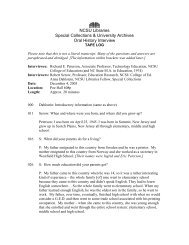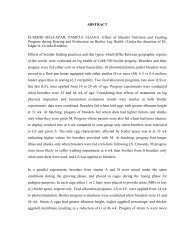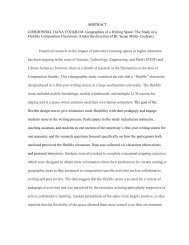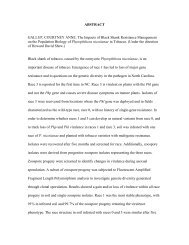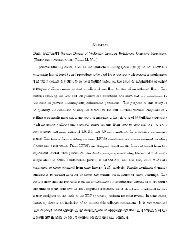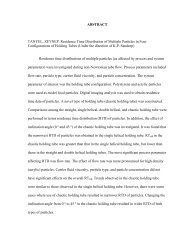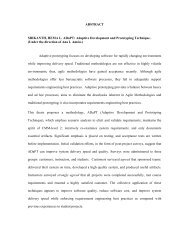SMITH, CHRISTINA JEAN. What Disappears and What Remains
SMITH, CHRISTINA JEAN. What Disappears and What Remains
SMITH, CHRISTINA JEAN. What Disappears and What Remains
Create successful ePaper yourself
Turn your PDF publications into a flip-book with our unique Google optimized e-Paper software.
Scientists who chase invention <strong>and</strong> advancement <strong>and</strong> seldom question the moral/ethicalramifications -- they certainly still played their part in the creation of this new apocalypse.Thus, Miller has Zerchi die a fitting death under the weight of the very church that harboredthose first remnants of scientific knowledge. We can only assume that his body will rotslowly in the open air <strong>and</strong> that he will certainly not receive a proper burial like Dom Paulo oreven a cursory funeral in the gut of some wild dog or coyote - since the radioactive falloutwill make short work of them as well. His death is representative both of the period inwhich he dies (one filled with the manipulation of natural orders <strong>and</strong> physical laws <strong>and</strong> onefilled with equally unnatural ways of living <strong>and</strong> dying) <strong>and</strong> the cycle as a whole. He diesprimarily from the crushing weight of the church <strong>and</strong> secondarily from the radioactive falloutthat will ensure his demise if internal injuries or thirst don't kill him first. 8Another way in which Miller reiterates the hopelessness <strong>and</strong> determinism of thetechno-primitive cycle of history, as well as the doleful hurriedness that accompaniestechnological advancement, is shown in his usage <strong>and</strong> compression of time as the threesections progress. In section one, time is, from the modern readers point of view,agonizingly slow. It takes place over a 30-year period <strong>and</strong> the story opens with Francis in the8 Zerchi's fate is not as bleak as those of the horribly burned mother <strong>and</strong> child who seek out his advice earlier in SectionThree. Zerchi attempts to dissuade the desperate mother from going to the mercy tents that have been set up to euthanize the"red ticket", terminally injured citizens. In showing this interaction, Miller further implicates the Church's complicatedplace in the techno-primitive cycle. Zerchi serves as gaoler to the woman <strong>and</strong> child in more ways that one, Miller shows us,since the Church contributed to the creation of the nuclear technology that has so badly burned her but Zerchi himself tellsher that she should not seek relief though euthanasia lest she damn her soul. Zerchi does finally give her a ride to the MercyCamps when he sees her attempting to hobble down the highway, toward the camp, with her burned child. Am<strong>and</strong>aCockrell noted of this complicated interplay: "The will of the Church to serve as preserver, even of that which willultimately be its downfall, is a thread which runs through all three sections of the novel, ending with 'Fiat Voluntas Tua',Part Three, in which mankind has rediscovered nuclear weapons <strong>and</strong> is obliterating itslef with them once more. In the chaosthe Church clings to this imperative: urging the terminally radiation poisoned to go to the Mercy Camps for euthenasia <strong>and</strong>launching a h<strong>and</strong>ful of novices <strong>and</strong> sisters <strong>and</strong> a group of children on a spaceship away from the doomed earth. With themtravel the 'Memorabilia'…<strong>and</strong> (thus) the possibility that the…destruction will begin again on another world" (25-26).Cockrell's analysis seems a bit far-fetched since she seems to interpret Miller as damning the church without reservation; thetext, however, shows Miller straddling the line between damnation <strong>and</strong> absolution of the Church.15



